#potassium-penguin
Explore tagged Tumblr posts
Note
Love the ducks! Especially the tiny ones. Would love to hear the taz characters as ducks thoughts
get ready to regret this !!
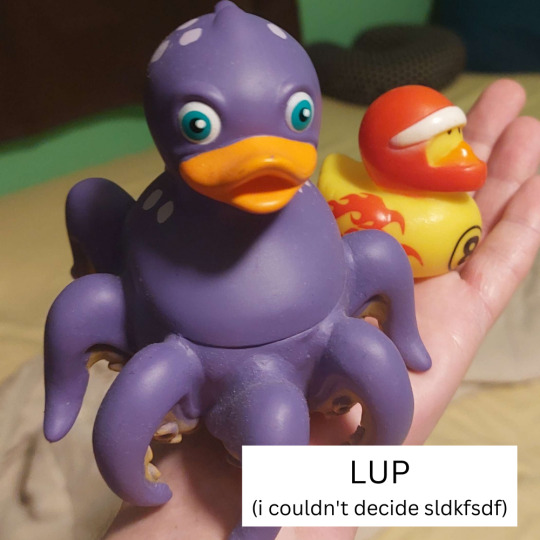


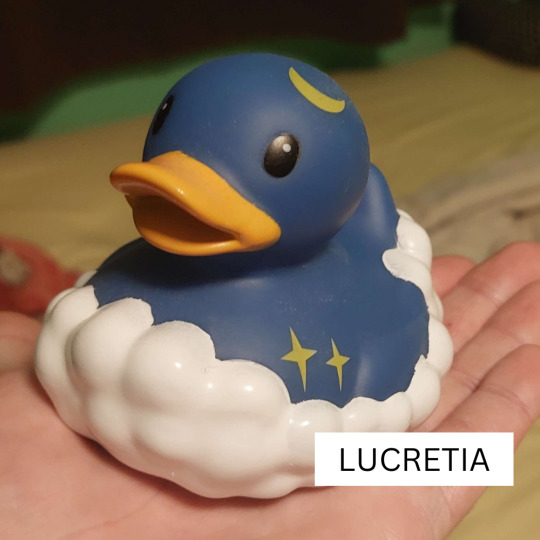



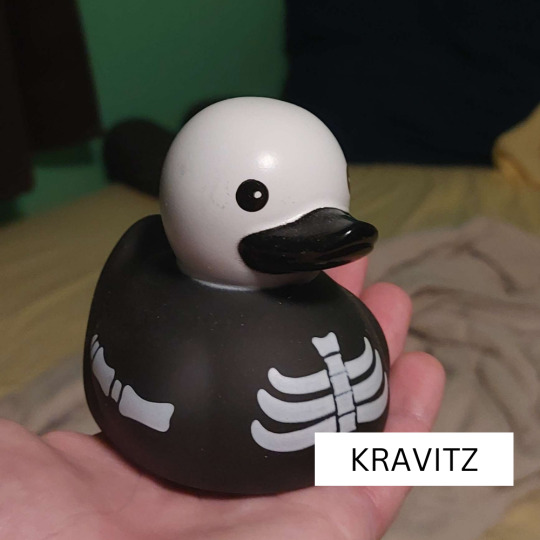
all image id's are in alt!
i could go on w more but i don't have the energy rn sdlfsdf. please enjoy this selection! Only three of these are new (the racecar one for Lup, the unicorn one for Taako, and the flower pot one for Merle), the rest I have collected at other assorted times.
The Kravitz duck was actually a birthday gift!! And my mom used to have the Barry duck in her classroom because it also looks incredibly like my dad, down to the outfit and glasses shape sldfsdf.
Thank you for indulging me sldfksdf
Below the cut are some alternatives, because I honestly had a very hard time choosing!!


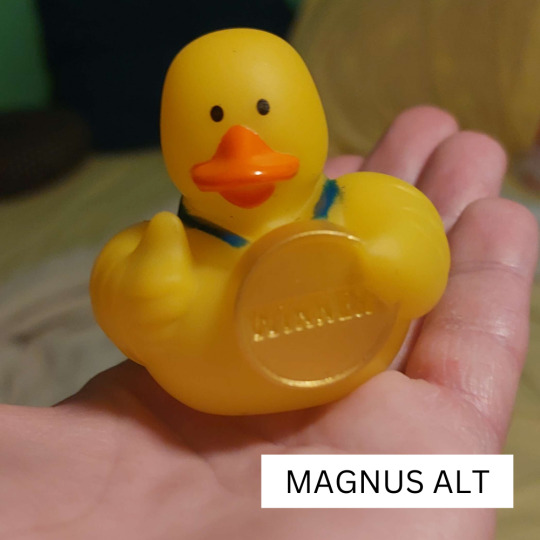
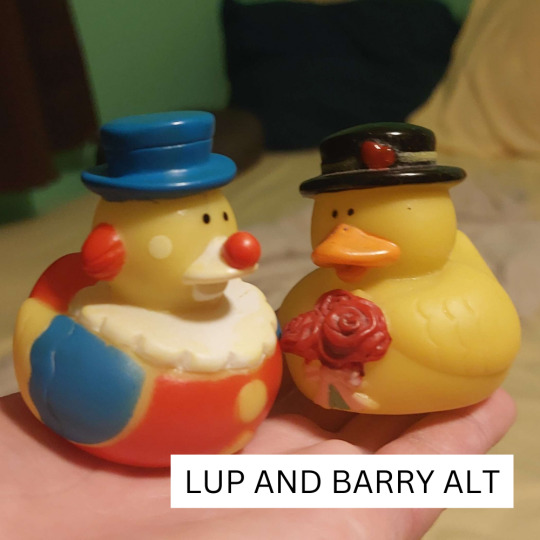
if it's not obvious, for the second image, the back duck is Taako and the front duck is Lup! And for the last image, the clown duck is Lup and the rose duck is Barry!!
#taz#taz balance#that's right im making everyone look at these#im proud of them all#asks#potassium-penguin#incredible username btw sdlfsfd#ise cube answers#i am speaking#damn tumblr really fucked up how this was formatted#it was supposed to be neat little boxes >:(#long post#*now* ig !
35 notes
·
View notes
Text





potassium by mary soon lee
#not tagging this for the elemental thingy bc i think its ugly and not worthy of being there but. i wanted to make something. so.#also someone already did potassium. so. idk.#kris letang#myedit#nhl#pittsburgh penguins
41 notes
·
View notes
Note
Top 5 bookstores (or other fun shops)?
ooh this is a good question. I feel like I say that about every one of these but maybe you guys are just on a roll
McNally Jackson (New York City). My single favorite go-to bookstore in NYC. I miss it. I have complicated feelings about the way they organize their fiction section, but overall their curation and setup - in all their locations - is both beautifully organized and well selected.
Powell's Books (Portland). Iconic for a reason. I love a bookstore with both used and new books, and a bookstore that's huge that I can explore for hours, potentially, and this fulfills both needs. Also just a stellar fantasy/sci-fi collection, including things I can't/couldn't find anywhere else.
Elliot Bay Books (Seattle). This is a little bit of hometown favoritism, but also it's another "combo of used and new" winner and, again, feels nice and cozy in terms of aesthetic, even if I kind of miss their Pioneer Square location layout.
Cosmic Monkey Comics (Portland). It's not the prettiest comic book shop I've been in, but the selection was great and the back issues options in particular were stellar. I'd recommend it over some more well-known/commonly recommended comic book stores in the city.
Foyles (London). I'm sure there are better bookstores in London, and I even went to at least one nice one, but I was just visiting for a short time and this one was a winner mostly for its selection of academic books and, again, the "I could spend a long time here" browsing factor.
rip to Churchmouse Yarns & Teas, which was one of my favorite non-bookstore stores and, alas, no longer exists with an actual storefront.
18 notes
·
View notes
Note
batfam members being the smartest and dumbest person in the room at the same time
Damian: Here's the plan: we wait for your mother to put the pie on the windowsill to cool. Then, I'll spoof a call to her work phone in order to draw her away. That's when you come in and take it. Are we clear?
Jon: *walks up to Lois*
Jon: Mom, can Damian and I have a piece of pie?
Lois: Of course, here you go.
———————
Cullen: I tripped over my shoelaces again.
Harper: I can make self-tying shoelaces that can only come apart when you use a password-protected app.
Cullen: ...I was just thinking of wearing velcro.
———————
Duke: Check out my project! Not to brag, but I think I know who's winning the science fair.
Izzy: What is it?
Duke: It's a chamber that excites nanoparticles to generate short-term high-intensity thermal energy that can alter organic matter to make them suitable for human consumption. What do you think?
Izzy: Funny, I have one at home. Only I call it a microwave.
———————
Dinah and Babs: *talking*
Dinah: One sec, I'm getting a call.
Dinah: *answers her phone*
Dinah, immediately hanging up: Never mind.
Barbara: Was your number leaked? I have a list of possible suspects and plans for dealing with each one.
Dinah: Relax, it was just spam.
———————
Bernard, with a mic: Welcome back to MasterChef: Young Justice. We're down to our finalists, Red Robin and Spoiler. Let's see what they brought us today.
Tim: I made a nutrient-dense mass-conserving meal replacement with all essential components compressed in a gelatinous cube for a quick, on-the-go meal during our off-world missions. I'm serving it with a protein shake served in a vacuum-sealed pouch made completely out of recycled materials.
Steph: I made authentic Belgian waffles using techniques dating back to the 1958 Brussels World Fair. I'm serving it with a warm Swiss chocolate ganache, Japanese white strawberries, and homemade ube powdered sugar. For a drink, we have a cappuccino made with fair-trade Colombian dark roast beans and milk sourced from local farmers.
Kon, Bart, and Cassie: *taste and discuss*
Kon: You're both eliminated.
Tim and Steph: What?!
Cassie: Red Robin, the point of this competition is to showcase taste and culinary artistry, not just your engineering skills.
Bart: And Spoiler, you were supposed to make soup.
———————
Cass: *sneaks out her room*
Cass: *rolls down the hall*
Cass: *jumps over the couch*
Cass: *crawls through the vents*
Cass: *climbs down the rafters*
Cass: *slides down a gas pipe into the Batcave*
Cass: *lands in front of the door*
———————
Dick: I'll infiltrate the Iceberg Lounge with my state-of-the-art wearable camouflage that uses reverse psychology to throw all suspicions off of me by catching people's attention in a completely different way.
Jason: Pfft, lame. You should check out my latest tech. It's a potassium nitrate–based mixture that can be activated with a built-in timer to both create a diversion and incapacitate more of the Penguin's cronies at once.
Dick: That's stupid. We need to be subtle.
Jason: No, what we need is efficiency.
Dick: Roy, what do you think?
Roy, looking up from his phone: I think one of you wants to dress in drag and the other made a bomb.
———————
Bruce: I need the kids to steer clear of Crime Alley tonight so I can deal with a situation but I don't want to bench them because then they'll be mad at me. Any ideas?
Alfred: Give them paperwork.
Selina: Send them on a wild goose chase.
Kate: Get them to bench themselves.
Renee: Wow.
Renee: You all suck.
#dick grayson#jason todd#tim drake#damian wayne#duke thomas#cullen row#stephanie brown#cassandra cain#barbara gordon#harper row#kate kane#alfred pennyworth#selina kyle#bruce wayne#batman#super sons#young justice#teen titans#we are robin#birds of prey#batfam#batfamily#batboys#batkids#batsiblings#batman family#incorrect batfamily quotes#incorrect quotes#incorrect dc quotes#dc comics
1K notes
·
View notes
Text
boatem crew time :D
Scar: If you put a milkshake in one yard and crack open a cold one in another yard, which yard would the boys go to?
Grian: Schrödinger's boys.
Pearl: FUCK!
Impulse: What about cracking open a cold milkshake?
Mumbo: As we all know, the milkshake brings the boys to the yard. The presence of the boys is a prerequisite for the cracking open of a cold one, but cold ones do not have any inherent boy-attracting abilities. Milkshakes, however, do.
Mumbo: All else being equal, the boys would proceed to the milkshake yard. While it is possible to announce the presence of cold ones in the hope of attracting some boys, the pull of the milkshake is much more powerful by comparison.
Scar: ...
Grian: ...
Pearl: ...
Impulse: ...
Mumbo: Mind you, all of this nonsense hinges on whether or not the boys are back in town.
Impulse: *visiting the squad* Hello, I just came to-
Impulse: *sees Pearl shoving Grian into the washing machine while Mumbo records and Scar watches*
Impulse: *retreating* Something suddenly came up.
*In a group chat* Scar: A pegan just flew into my window.
Pearl: Pegan?
Mumbo: A what?
Grian: Ah yes, my favourite bird, Pegan.
Impulse: I thought you said penguin for a second, LMAO!
Grian: Just a normal day with flying penguins crashing into my window.
Impulse: You have pigeons flying into your window? Can't relate, I have penguins flying into my window.
Scar: I literally just made a typo-
Grian: So oxygen went on a date with potassium, it went... OK.
Scar: I thought oxygen was dating magnesium, OMG.
Grian: Actually oxygen first asked nitrogen out, but nitrogen was all like NO.
Pearl: I thought oxygen had that double bond with the hydrogen twins.
Mumbo: Looks like someone's a HO.
Scar: NaBrO.
Impulse: I'm done with all of you!
should I just do this with pixilart scattered here and there?
114 notes
·
View notes
Text

The rare sound of Law's genuine laughter was even more satisfying than Morgans' pained squawks, and Ikkaku basked in her victory. It was good to see her captain smiling and having a bit of fun, regardless of whether or not it was at someone else's expense. Hell, considering the people they were surrounded by, the engineer was happy to put her brilliant mind to work to continue to ruin nights to improve Law's. She was nice like that.
Pure mischief lit up her dark eyes as she listened to his request. "Law, in the right hands, anything can be destructive," she chuckled. Looking around quickly to be sure everyone was paying more attention to the commotion caused by the Mink than the conversation between the newest shichibukai and his subordinate, Ikkiaku carefully pulled out a few gadgets made to look like ordinary objects that would be in any lady's purse. "I've got a 4.5mm pistol capable of firing a single .177-calibre round disguised as a tube of lipstick, plus a pen that's actually a syringe filled with tranquilizer. Though, personally I'm saving those for a certain clown if he gets too close. Then there's my compact with a flash dial in it that can blind a whole room. Oh, and I've got a little perfume bottle full of toxic highly flammable gas."
While Ikkaku was pleased with these gadgets, she knew they weren't quite at the level of destructiveness her captain would want. Thankfully, she'd come prepared, considering how she still wasn't entirely convinced that the World Government wasn't looking to execute them the second they let their guards down. "I also managed to get my hands on an axe dial and had Penguin and Shachi go to town on it for a good few hours. The amount of slashes stored inside of it will definitely cause some major damage. Oh, and of course I have some miniature limpet mines we can attach wherever we please to make shit blow up. But sometimes real beauty comes from simplicity."
Lifting up one more section of her petticoat, she revealed several small canisters lined up like gun magazines. "Potassium metal. Soft and unassuming, but ignites and explodes in water. Which this fancy manor has lots of, from toilets to punch bowls to fancy-ass fountains. So, wanna help me give these people a science lesson or two, Boss?"

An eyebrow arches at the device his engineer reveals. It’s small and Law wonders what she’s used to construct it. Is there a tone dial in there somewhere? He decides to question her about whatever gadgets she produces at the end of this night because right now there is a spectacle to see. His gaze turns to Morgans just in time to see him freak out, squawking as he flees the room. Law hears no sound, and he wonders if Bepo would have heard whatever the bird mink does if he was here. The surgeon’ face breaks out into a grin, genuine laughter escaping him. He makes no attempt to hide his merriment. The exclamations of alarm and amusement from the other party-goers masks his laugh well enough.
“That was excellent,” Law says, stepping closer to Ikkaku and dropping his voice so anyone close won’t hear. He doesn’t want their mischief to be discovered just yet.
She asks if he wants to ruin anyone else’s night and frankly he’d like to ruin this whole event. A Room up and a few slicing motions with a butter knife would do the trick but unfortunately that would likely end in some real problems for him. Better they do something a little more subtle. Law does have a few more specific people he’d like to fuck with, Doflamingo for one, but that’d set off other problems. Perhaps even reveal his intentions. Can’t have that.
“Before we pick targets,” he continues, the doctor shifting his position so he can hide Ikkaku with his body. “I wanna know what else you’ve got in there. Anything … destructive?”
#medicus-mortem#The Engine is the Heart of the Ship (canon)#Oh Captain My Captain (Law)#warlord masquerade#Join the Hearts: We Have Uniforms#Warlords - What Are they Good For?#Assembly Line (queue)
7 notes
·
View notes
Text

POGTASSIUM
#penguin's art#deltarune#deltarune chapter 2#deltarune spoilers#banana#kris#ralsei#queen#acid river#KRIS GET THE BANANA#KRIS GOT THE BANANA#meme#fanart#i like this part its hilarious#queen is pogging#you know she would#potassium
634 notes
·
View notes
Text
DAILY ANTARCTICA REPORT. guh
Hey it’s me, Beloved Court Jester. Here with the news, or as I call the report.
(@bowlerhatwearer)
Uh, the Helioptile Egg crisis has been solved recently, and we have successfully traded off the eggs. This HAS led into the new Feebas crisis, but luckily this can be solved by opening up a fish processing plant somewhere on the coast, or maybe just putting a seafood restaurant somewhere here. The plutonium shortage still hasn’t been solved, but Y’know you win some you lose some
It is, yet again, a snow day, despite it not snowing today. It’s also a national holiday, Penguin Day, where we celebrate penguins by dropping them off cliffs onto comfortable mattresses. It’s a funny video game reference.
We’ve also had a recall on grape flavour snow cones. There’s been a mix up with the overseas importing system, and the grape colouring is actually potassium permanganate, so maybe don’t eat those. We also ended up receiving a bunch of colourful lightbulbs for our mascot @sallychaosaura from an unknown source which is pretty cool
As for new laws and the happenings of the political world, you can have a fav if they aren’t canonically a golfer, otherwise that is a $7 fine. We also burnt @northerngrail’s cat boy again but at this point it’s just fun to do. By the way, scientists doing research on Emperor Penguin populations, please stop leaving your trash everywhere. I keep eating it and it tastes yucky.
This is your court jester, signing off.
god I’m glad they haven’t explored much of the north Orkney islands
4 notes
·
View notes
Photo
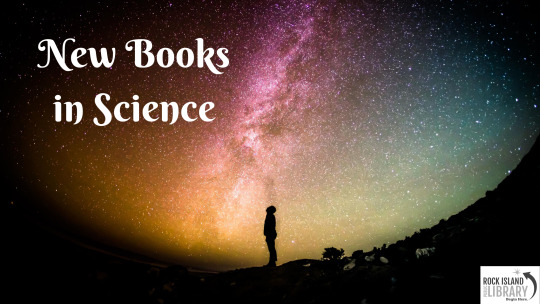
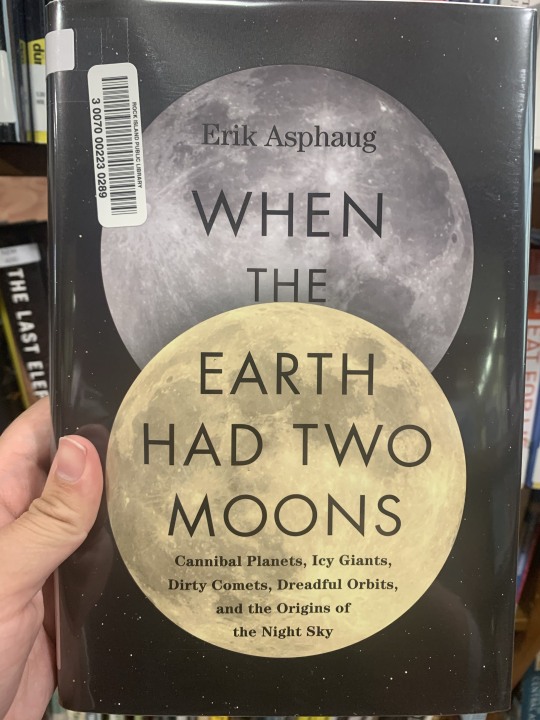
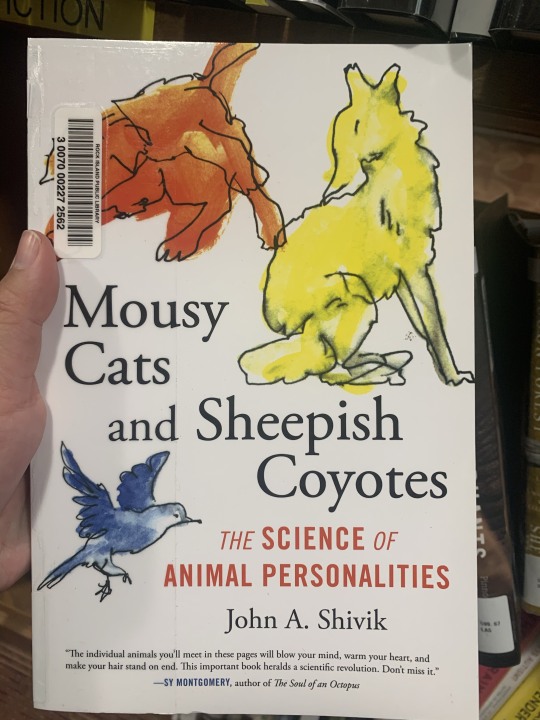
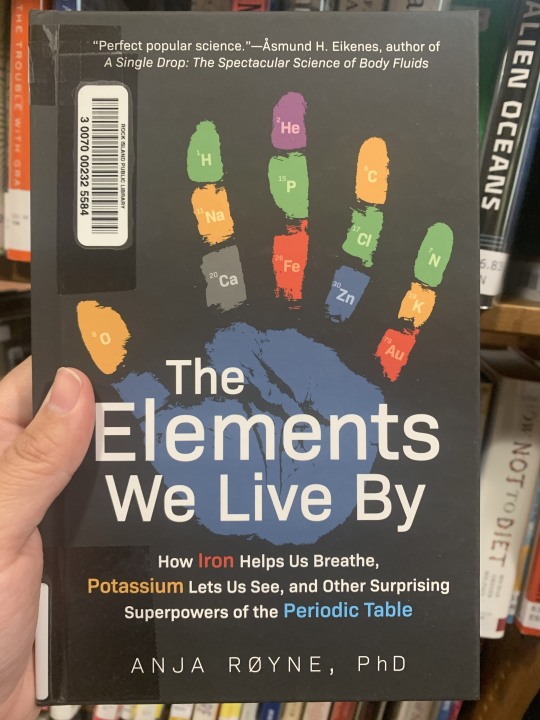
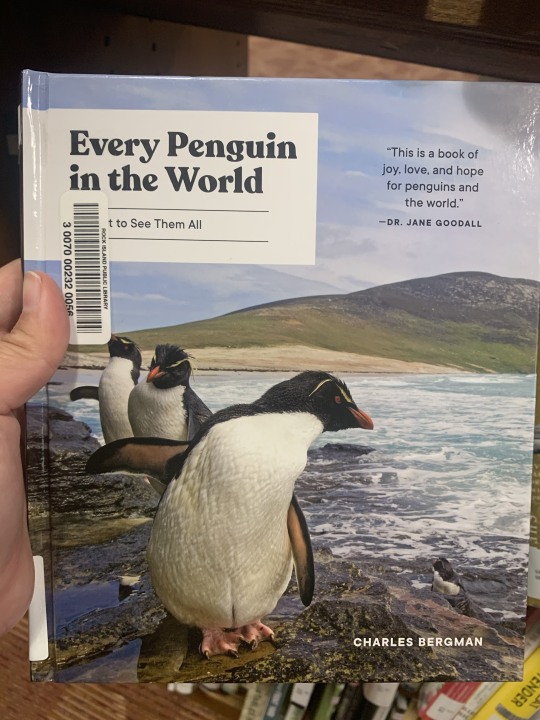
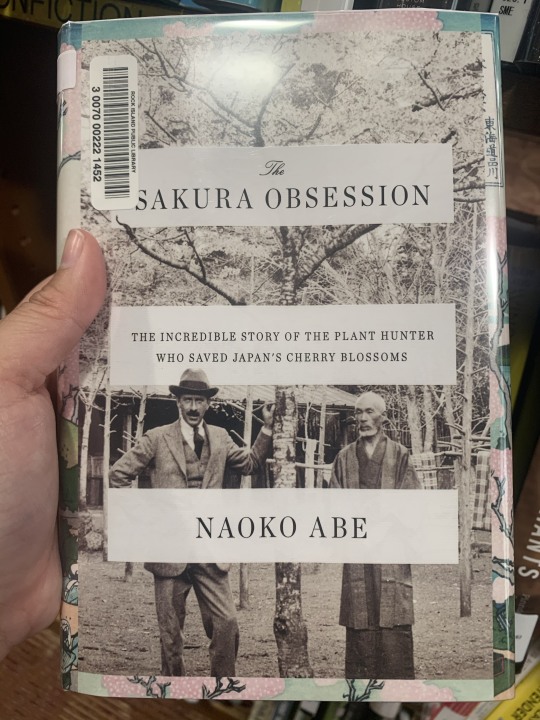
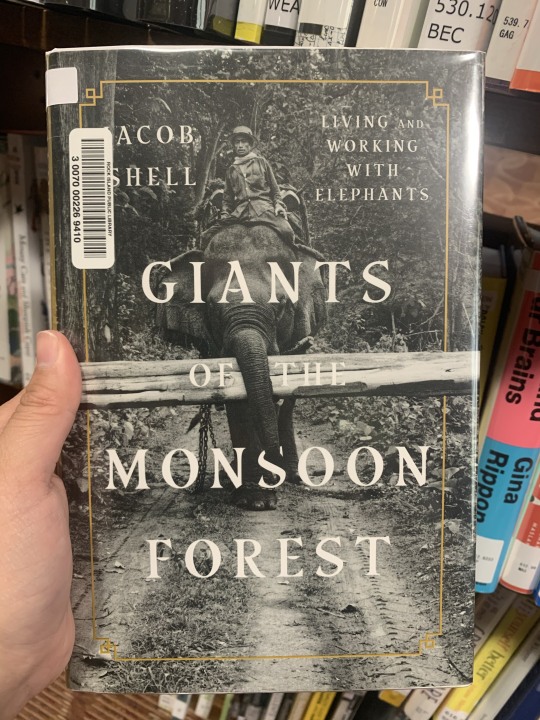
New non-fiction titles in the 500′s!
Summaries from Goodreads.com; Title link will bring you our local catalog
When the Earth Had Two Moons: Cannibal Planets, Dreadful Orbits, Icy Giants, Dirty Comets and the Origins of Today's Night Sky by Erik Asphaug
An astonishing exploration of planet formation and the origins of life by one of the world’s most innovative planetary geologists.
In 1959, the Soviet probe Luna 3 took the first photos of the far side of the moon. Even in their poor resolution, the images stunned scientists: the far side is an enormous mountainous expanse, not the vast lava-plains seen from Earth. Subsequent missions have confirmed this in much greater detail.
How could this be, and what might it tell us about our own place in the universe? As it turns out, quite a lot.
Fourteen billion years ago, the universe exploded into being, creating galaxies and stars. Planets formed out of the leftover dust and gas that coalesced into larger and larger bodies orbiting around each star. In a sort of heavenly survival of the fittest, planetary bodies smashed into each other until solar systems emerged. Curiously, instead of being relatively similar in terms of composition, the planets in our solar system, and the comets, asteroids, satellites and rings, are bewitchingly distinct. So, too, the halves of our moon.
In When the Earth Had Two Moons, esteemed planetary geologist Erik Asphaug takes us on an exhilarating tour through the farthest reaches of time and our galaxy to find out why. Beautifully written and provocatively argued, When the Earth Had Two Moons is not only a mind-blowing astronomical tour but a profound inquiry into the nature of life here—and billions of miles from home.
Mousy Cats and Sheepish Coyotes: The Science of Animal Personalities by John Shivik
In Mousy Cats and Sheepish Coyotes, Shivik serves as an accessible, humorous guide to the emerging body of research on animal personalities. Shivik accompanies researchers who are discovering that each wolf, bear, and coyote has an inherent tendency to favor either its aggressive nature or to shyly avoid conflicts. Some bluebirds are lovers, others are fighters. And some spiders prefer to be loners, while others are sociable. Unique personalities can be discovered in every corner of the animal kingdom--even among microscopic organisms. The array of personality types among all species is only beginning to be described and understood.
The Elements We Live By: How Iron Helps Us Breathe, Potassium Lets Us See, and Other Surprising Superpowers of the Periodic Table by Anja Røyne
An around-the-world journey to discover where in the wild we can find the elements of life and the surprising ways they’re essential to our survival.
We all know that we depend on elements for survival—from the oxygen in the air we breathe to the carbon that forms part of the structure of all living things. But how many of us appreciate the ways our bodies also depend on phosphorous, say, to hold our DNA together, or potassium to power our optic nerves so that we can see?
In The Human Elements, physicist and award-winning author Anja Røyne takes us on an astonishing journey through chemistry and physics, introducing the building blocks from which we humans—and the world—are made. Not only does Røyne explain why our bodies need iron, phosphorus, silicon, potassium, and many more elements in just the right amounts in order to function properly; she also takes us on a tour around the world to where these precious elements are found (some of them in ever-shrinking quantities).
Røyne makes us understand how precarious the balance that keeps us and our environment alive really is, how there are finite amounts of our life-giving elements available to us, and how, from the smallest to the grandest scale, the world and everything that lives in it are wonderfully interconnected. The Human Elements will make you look at the world and your place in it in an entirely new way.
Every Penguin in the World: A Quest to See Them All by Charles Bergman
A narrative and photographic book about the author's pursuit of penguins-to see each variety of the species in its natural habitat. This book tracks the author's forays around the southern hemisphere, from the Galapagos to South Africa to the Antarctic in his quest to see all the penguins in the world. The sections of the book are organized around themes of adventure, human-animal connection, and conservation-in which stories of each penguin species will be touched upon.
The Sakura Obsession: The Incredible Story of the Plant Hunter Who Saved Japan's Cherry Blossoms by Naoko Abe
The remarkable 1,200-year history of the Japanese cherry blossom tree--and how it was saved from extinction by an English gardener.
Collingwood "Cherry" Ingram first fell in love with the sakura, or cherry tree, when he visited Japan on his honeymoon in 1907. So taken with the plant, he brought back hundreds of cuttings with him to England, where he created a garden of cherry varieties. In 1926, he learned that the Great White Cherry had become extinct in Japan. Six years later, he buried a living cutting from his own collection in a potato and repatriated it via the Trans-Siberian Express. In the years that followed, Ingram sent more than 100 varieties of cherry tree to new homes around the globe, from Auckland to Washington. As much a history of the cherry blossom in Japan as it is the story of one remarkable man, the narrative follows the flower from its adoption as a national symbol in 794, through its use as an emblem of imperialism in the 1930s, to the present-day worldwide obsession with forecasting the exact moment of the trees' flowering.
Giants of the Monsoon Forest: Living and Working with Elephants by Jacob Shell
High in the mountainous rainforests of Burma and India grow some of the world’s last stands of mature, wild teak. For more than a thousand years, people here have worked with elephants to log these otherwise impassable forests and move people and goods (often illicitly) under cover of the forest canopy. In Giants of the Monsoon Forest, geographer Jacob Shell takes us deep into this strange elephant country to explore the lives of these extraordinarily intelligent creatures. The relationship between elephant and rider is an intimate one that lasts for many decades. When an elephant is young, he or she is paired with a rider, who is called a mahout. The two might work together their entire lives. Though not bred to work with humans, these elephants can lift and carry logs, save people from mudslides, break logjams in raging rivers, and navigate dense mountain forests with passengers on their backs. Visiting tiny logging villages and forest camps, Shell describes fascinating characters, both elephant and human—like a heroic elephant named Maggie who saves dozens of British and Burmese refugees during World War II, and an elephant named Pak Chan who sneaks away from the Ho Chi Minh Trail to mate with a partner in a passing herd. We encounter an eloquent colonel in a rebel army in Burma’s Kachin State, whose expertise is smuggling arms and valuable jade via elephant convoy, and several particularly smart elephants, including one who discovers, all on his own, how to use a wood branch as a kind of safety lock when lifting heavy teak logs. Giants of the Monsoon Forest offers a new perspective on animal intelligence and reveals an unexpected relationship between evolution in the natural world and political struggles in the human one. Shell examines why the complex tradition of working with elephants has endured with Asian elephants, but not with their counterparts in Africa. And he shows us how Asia’s secret forest culture might offer a way to save the elephants. By performing rescues after major floods—as they did in the wake of the 2004 Indian Ocean tsunami—and helping sustainably log Asian forests, humans and elephants working together can help protect the fragile spaces they both need to survive.
#science#science books#nonfiction#non fiction#non-fiction#reading recommendations#reading recs#book recs#Book Recommendations#currently reading#animals#elephants#sakura#space and time#astronomy#penguins#animal personalities#space
2 notes
·
View notes
Text
*inhale*
-the moral ABC that unites all mankind free, instantly- 2nd: Yet, if I'm only for me, what am I? Nothing! 3rd- 4th: Only hard work-God's Law can save us, but if we teach- -truth, hard-work, free speech, press & profitsharing Moral ABC- -Abraham & Israel, since the year One! "LISTEN CHILDREN ETER- -whatever divides us! Yet if absolute unselfish I am not for me- -me, like every arctic owl-penguin-pilot-cat-swallow-beaver-bee, ca-
FAMILY SOAPMAKERS SINCE 1858
18-IN-1 HEMP PEPPERMINT
PURE-CASTILE SOAP
CERTIFIED FAIR TRADE
MADE WITH ORGANIC OILS
INGREDIENTS: Water, Organic Coconut Oil,* Potassium Hydroxide, Organic Palm Kernel Oil,* Organic Olive Oil,* Mentha Arvensis, Organ- ic Hemp Seed Oil, Organic Jojoba Oil, Mentha Piperita, Citric Acid, Tocopherol
*certified fair trade ingredients. ✝️None remains after saponifying oils into soap & gly-
PURE-CASTILE MEANS SOAP MADE FROM PLANT OILS WITHOUT SYNTHETIC DETERGENTS
2-3x than many leading liquid soaps, cleansers & body washes.- with water. Clouds when cold. Put in warm room/water. Clears at about 70°F.
WARNING! Keep out of eyes. If cap clogs, poke it clear. Do not squeeze bottle and shoot out soap. Soap can clog and spurt with dispensers. Flush eyes will with water for 15 minutes. Consult physician if irritation persists. Don't drink s-
DR. BRONNER'S
ALL-ONE!®
MAGIC SOAPS
IN ALL WE DO, LET US BE Generous, fair & loving to spaceship Earth and - its inhabitants. For we're ALL-ONE OR NONE! ALL--
-pilot-provider-lover-teacher-mate, no half-true- -without fault? He's dead! Do one thing at a time. Work hard! Get- -. Little is always worthwhile! To the fearless are given crowns. - -... Spectacular restoration!! So, help teach the human race-
-from perfect Adam & Eve to sinful sinner, brother's keeper,- -brother's teacher of--, tent & sandalmaker- --Raised-trained-
And that's everything I can read

Y’all see this shit? This stuff is single handily the most potent soap i have ever used. I feel so unimaginably clean like there is not a spec of sweat, dirt, or oil left on my body. This will make you question if you have ever actually been clean before
48 notes
·
View notes
Note
Which Crazy Gotham Villain Are You? I Got The Penguin!
81 notes
·
View notes
Text
TMI Thursday.
Here’s entirely too much information:
Guano (from Spanish guano, from Quechua: wanu) is the accumulated excrement of seabirds and bats. As a manure, guano is a highly effective fertilizer due to its exceptionally high content of nitrogen, phosphate and potassium: nutrients essential for plant growth. Guano was also, to a lesser extent, sought for the production of gunpowder and other explosive materials. The 19th-century guano trade played a pivotal role in the development of modern input-intensive farming, but its demand began to decline after the discovery of the Haber-Bosch process of nitrogen fixing led to the production of synthetic fertilizers. The demand for guano spurred the human colonization of remote bird islands in many parts of the world. During the 20th century, guano-producing birds became an important target of conservation programs and influenced the development of environmental consciousness. Today, guano is increasingly sought after by organic farmers.[1]
Contents
1Composition
2History
3Sourcing
4Properties
5In popular culture
6See also
7References
8Further reading
9External links
8.1Africa
8.2Chile
8.3Peru
8.4Documents
Composition[edit]
Paul Szpak has co-authored several journal articles claiming that seabird guano consists of nitrogen-rich ammonium nitrate and urate, phosphates, as well as some earth salts and impurities, and that unleached guano from favored locales, such as the Chincha Islandsoff the coast of Peru, typically contains 8 to 16 percent nitrogen (the majority of which is uric acid), 8 to 12 percent equivalent phosphoric acid, and 2 to 3 percent equivalent potash.[2][3]
However, The Association of American Plant Food Control Officers (AAPFCO) defines Seabird guano as the hardened excrement from marine birds, which contains no organic matter or nitrogen and is a source of phosphates P2O5: "P- Hydroxylapatite - is a naturally-formed phosphate rock mineral with the formula Ca5(PO4)3(OH). The Fluorine content is less than 1%."[4]
Bat guano is fecal excrement from bats. Commercially harvested bat guano is used as an organic fertilizer.[5][6] All commercially sold bat guano is derived from insect-eating bats.[7]A study was done that demonstrated that, for fruit bats and insect bats, the composition of their guano was largely the same, and differed mainly based on their diet.[8]
History[edit]
Chincha Islands where guano was found in abundance. Mining was done on site and ships transported it to Europe.
Mining guano in the
Chincha Islands
off the central coast of
Peru
c. 1860.
Advertisement for guano, 1884
The word "guano" originates from the Andean indigenous language Quechua, which refers to any form of dung used as an agricultural fertilizer. Archaeological evidence suggests that Andean people have collected guano from small islands and points located off the desert coast of Peru for use as a soil amendment for well over 1,500 years. Spanish colonial documents suggest that the rulers of the Inca Empire assigned great value to guano, restricted access to it, and punished any disturbance of the birds with death. The Guanay cormorant has historically been the most abundant and important producer of guano. Other important guano producing species off the coast of Peru are the Peruvian pelican and the Peruvian booby.[1][3]
In November 1802, Alexander von Humboldt first encountered guano and began investigating its fertilizing properties at Callao in Peru, and his subsequent writings on this topic made the subject well known in Europe. During the guano boom of the nineteenth century, the vast majority of seabird guano was harvested from Peruvian guano islands, but large quantities were also exported from the Caribbean, atolls in the Central Pacific, and islands off the coast of Namibia, Oman, Patagonia, and Baja California. At that time, massive deposits of guano existed on some islands, in some cases more than 50 m deep.[9] In this context the United States passed the Guano Islands Act in 1856, which gave U.S. citizens discovering a source of guano on an unclaimed island exclusive rights to the deposits. Nine of these islands are still officially U.S. territories.[10] Control over guano played a central role in the Chincha Islands War (1864–1866) between Spain and a Peruvian-Chilean alliance. Indentured workers from China played an important role in guano harvest. The first group of 79 Chinese workers arrived in Peru in 1849; by the time that trade ended a quarter of a century later, over 100,000 of their fellow countrymen had been imported. There is no documentary evidence that enslaved Pacific Islanders participated in guano mining.[11] Between 1847 and 1873, there was a significant increase in Peruvian guano exports, and the revenue from this momentarily ended the fiscal necessity of the colonial head tax.[12]
After 1870, the use of Peruvian guano as a fertilizer was eclipsed by saltpeter in the form of caliche extraction from the interior of the Atacama Desert, not far from the guano areas. During the War of the Pacific (1879–1883) Chile seized much of the guano as well as Peru's nitrate-producing area, enabling its national treasury to grow by 900% between 1879 and 1902 thanks to taxes coming from the newly acquired lands.[13] Contrary to popular belief, seabird guano does not have high concentrations of nitrates, and was never important to the production of explosives; bat and cave-bird deposits have been processed to produce gunpowder, however. High-grade rock phosphate deposits are derived from the remobilization of phosphate from bird guano into underlying rocks such as limestone.[14] In 1990 a group of French researchers, from isotope studies, proposed a marine sedimentation origin for some high-grade phosphate deposits on Nauru.[15][16]
Since 1909, when the Peruvian government took over guano extraction for use by Peru farmers, the industry has relied on production by living populations of marine birds. U.S. ornithologists Robert Cushman Murphy and William Vogt promoted the Peruvian industry internationally as a supreme example of wildlife conservation, while also drawing attention to its vulnerability to the El Niño phenomenon. South Africa independently developed its own guano industry based on sustained-yield production from marine birds during this period, as well. Both industries eventually collapsed due to pressure from overfishing.[1]The importance of guano deposits to agriculture elsewhere in the world faded after 1909 when Fritz Haber developed the Haber-Bosch process of industrial nitrogen fixation, which today generates the ammonia-based fertilizer responsible for sustaining an estimated one-third of the Earth's population.[17]
DNA testing has suggested that new potato varieties imported alongside Peruvian seabird guano in 1842 brought a virulent strain of potato blight that began the Irish Potato Famine.[18][19]
Sourcing[edit]
A
herring gull
(
Larus argentatus
) excreting waste near
Île-de-Bréhat
.
The ideal type of guano is found in exceptionally dry climates, as rainwater volatilizes and leaches nitrogen-containing ammonia from guano. In order to support large colonies of marine birds and the fish they feed on, these islands must be adjacent to regions of intense marine upwelling, such as those along the eastern boundaries of the Pacific and South Atlantic Oceans.[9]
Bat guano is usually mined in caves and this mining is associated with a corresponding loss of troglobytic biota and diminishing of biodiversity. Guano deposits support a great variety of cave-adapted invertebrates, that rely on bat feces as their sole source of nutrition. In addition to the biological component, deep guano deposits from birds and bats contain local paleoclimatic records and evidence of other environmental changes in strata that have built up over thousands of years, which are unrecoverable once disturbed.[20]However, when done with caution, extraction of guano can be done alongside marine bird colonies without causing them significant harm.[21][22]
Post-depositional decomposition and ammonia volatilization of penguin guano also plays an important role in the evolution of ornithogenic sediments in the cold and arid environment of Antarctica (McMurdo Sound of the Ross Sea region, East Antarctica).[23]
Properties[edit]
In agriculture and gardening guano has a number of uses, including as: soil builder, lawn treatments, fungicide (when fed to plants through the leaves), nematicide (decomposing microbes help control nematodes), and as composting activator (nutrients and microbes speed up decomposition).[24]
High in nitrogen, guano was also refined in the early 20th century into a precursor to explosives. This caused guano islands to be of strategic significance before the First World War.
In popular culture[edit]
"Guano's historical significance was as much cultural as it was ecological and economic."[25] References to guano in popular culture are an important sign of this cultural influence, especially regarding the ongoing relationship between guano and colonialism. In his 1845 poem "Guanosong", Joseph Victor von Scheffel used a humorous verse to take a position in the then-popular polemic against Hegel's Naturphilosophie. The poem starts with an allusion to Heinrich Heine's Lorelei and may be sung to the same tune.[26] The poem ends however with the blunt statement of a Swabian rapeseed farmer from Böblingen who praises the seagulls of Peru as providing better manure even than his fellow countryman Hegel. This refuted the widespread Enlightenment belief that nature in the New World was inferior to the Old World. The poem has been translated by, among others, Charles Godfrey Leland.[27]
In Joseph Conrad's 1900 novel Lord Jim the characters Chester and Captain Robinson attempt to recruit the eponymous lead character for an expedition harvesting guano.
The setting of Ian Fleming's 1958 installation in the James Bond series Dr. No is a Caribbean guano island, and the villain dies at the end buried in guano.
In Stanley Kubrick's 1964 film Dr. Strangelove, Colonel "Bat" Guano (Keenan Wynn) leads an attack on the airbase responsible for sending a nuclear attack order to bomb the Soviet Union.
The 1994 film Men of War centers on a band of mercenaries who are hired by an investment firm to seize a tropical island for its extensive guano deposits.
In the 1995 film Ace Ventura: When Nature Calls, Jim Carrey's character attempts to save an African tribe from being dispossessed of a fortune in bat guano.
Hungarian painter Judit Reigl had a series of paintings between 1958-1964. She used to protect the floor of her atelier with old and ruined canvasses. When she moved out, she discovered that over these years the paintings developed an interesting surface, and she carved her "Guano painting" from these.
5 notes
·
View notes
Note
You were a docent at an aquarium?? That's so cool! Can we have some aquatic facts?
I was! for a summer before I went to college I was a volunteer at the Seattle Aquarium. I loved it, it was great, probably the sort of thing I'd want to take up again if I get to retire
of course now that you ask me can't think of anything but the most basic ones but I will say two that came up a lot, which was:
Wolf eels (a) are not actually eels, they're technically closer to fish; they're the only member of their genus. Also they (b) are very curious and (c) have very, very strong jaws, and like carrots for snacks, so please don't stick your fingers into the tank where the juvenile wolf eel is, he's built to crunch things a lot harder than you with those teeth.
California sea lions can run up to 35 mph on land! The males are very territorial and can weigh upwards of 1,000 pounds. Please don't approach a group of wild sea lions on the beach.
particularly with (2) the number of people who would come up to me and tell me with delighted pride about the time they were this close to a sea lion and I can only imagine the 😬😬😬 look on my face before launching into my spiel about not approaching marine wildlife and tbh especially not sea lions
26 notes
·
View notes
Text
20 random facts about me...
🌻Caroline Aurora Greyson🌻
🔆1. I was named after the polar lights- no joke. My middle name Aurora is the actual name for the phenomenon more commonly known as the polar lights that can be seen near artic regions. My mom has always been fascinated by the polar lights and thought it would be beautiful to see so that's the meaning behind my middle name.
🔆2. I am scared of escalators. I know it seems so stupid and childish but to this day I still get so nervous and shakey if I have to ride on an escalator
🔆3. I have a thyroid condition that causes me to metabolize food too quickly so I don't absorb the vitamins, minerals, nutrients or calories correctly with out medication. Even on medication I get my blood tested regularly for deficiencies in all sorts of areas like vitamin d, potassium, iron, magnesium,etc...because many of these gone untreated have potential life threatening consequences. I get hospitalized often due to deficiencies and related issues resulting from them. My thyroid condition also makes it very difficult for me to gain/ maintain a healthy weight no matter how much I eat which is extremely difficult because I am in recovery for anorexia and Orthorexia so maintaining a normal weight is pretty important for me.
🔆4. My favorite colors are yellow, green and silver
🔆5. I've never attended an actual school before. Homeschooled my entire life...my brothers were also homeschooled all their lives.
🔆6. The only extended family I have is my aunt Mel (moms younger sister ) and my 2 cousins Kenzie and Grace and that is it for both sides of my family.
🔆7. My dream career is to be a published fiction novelist
🔆8. I am originally from new York but both my parents serve in the military so we have moved a lot. currently we live in Washington state and have for a little over 3 years now which is a record for the longest my family has lived in one place since I was 3 years old[I'm 17 now btw].
🔆9. I am allergic to strawberries, kiwis, lemons and shellfish.
🔆10. I take more pictures of my dogs than I do myself or my family. We have 8 dogs and I also have a pet hedgehog.
🔆11. I am actually not on any social media platform besides this tumblr account so I don't do Facebook, Instagram, snapchat, tiktok or anything. I just don't care for any of it...
🔆12. I love to bake. I learned to make bread from scratch when I was 14 and it is one of the most effective ways for me to calm and clear my mind. I don't know why
🔆13. I am very athletic. I take multiple dance classes a week. On average I spend about 22 hours a week dancing. I also play volleyball, soccer and tennis for local YMCA youth travel teams. Though I am not playing tennis competitively anymore...just don't have time between dance volleyball and soccer.
🔆14. My brothers, cousins and I are extremely close and some of our favorite things to do together include hiking, outdoor trail biking, going to the YMCA and playing on the rock climbing walls and we like to go to the drive in movies
🔆15. I play piano and next week I am starting lessons to learn to play the cello!! I am so excited!!!!
🔆16. My favorite non domesticated animal is the elephant but penguins are a close 2nd place lol
🔆17. My favorite movies of all time are I Am Legend, Fried Green Tomatoes, Flight Plan, Panic room, I Robot, the sisterhood of night, Matilda, Hair Spray, Rent and any/all James Bond movies .
🔆18. When I go for jogs I like to listen to classical music playlists on my spotify. I don't know why but for some backwards reason jogging to Beethoven just works for me😂🤣
🔆19. My favorite food is cereal like cold cereal and oatmeal both. Peanut butter is up there as well. Oh and I also love a good black bean burger even though I am neither vegan or vegetarian and sweet potatoes....anything sweet potato 🙂
🔆20. I love sucker's like the tootsie roll tootsie pop ones...I always have suckers and usually eat 4 or so a week but I have never had a cavity in my life 🤷♀️so can't be that bad for me right?
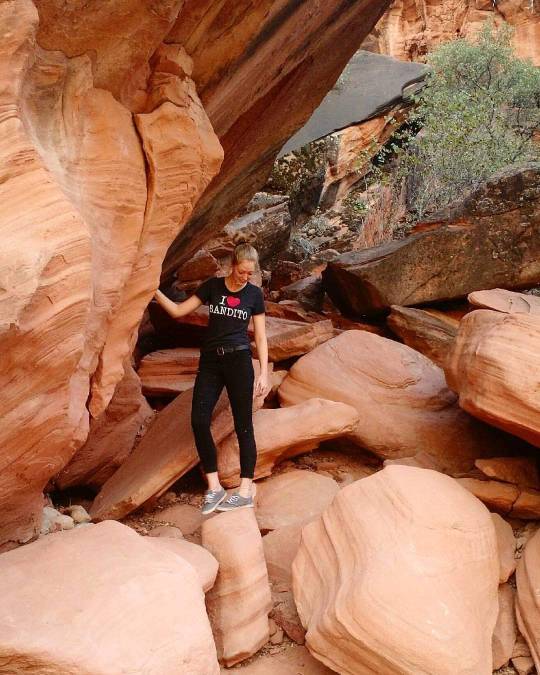
0 notes
Text

Indian scientists have discovered a new plant species in Antarctica.
Polar biologists stumbled upon a species of moss during an expedition to the ice-covered continent in 2017.
Identification is laborious, and it took the scientists five years to confirm that the species had been discovered for the first time.
The peer-reviewed paper describing this discovery has been accepted in the leading international journal, Journal of Asia-Pacific Biodiversity.
The biologists, based in the Central University of Punjab, have named the specie Bryum Bharatiensis. Bharati is the Hindu goddess of learning and the name of one of India's Antarctic research stations.
Prof Felix Bast, a biologist who was part of the six-month-long expedition to the continent - the 36th by Indian scientists - discovered the dark green specie at Larsemann Hills, overlooking the Southern Ocean, in January 2017. This is located near Bharati, one of the remotest research stations in the world.
Plants needs nitrogen, along with potassium, phosphorus, sunlight and water to survive. Only 1% of Antarctica is ice free. "The big question was that how does moss survive in this landscape of rock and ice," Prof Bast said.
The scientists found that this moss mainly grew in areas where penguins bred in large numbers. Penguin poop has nitrogen. "Basically, the plants here survive on penguin poop. It helps that the manure doesn't decompose in this climate," said Prof Bast.
0 notes
Photo

Corrosive dwarf Bipes or Hive Pebbles
These cave dwelling bipeds subsist off of iron potassium and sulfur found in rocks. This digestion occurs with the help of an internal lithotropic microbial ecosystem mostly featuring endoliths.
With the help of their protective structures these creatures are extremely resilient to high pressures, high temperatures, and high amounts of radiation. Their bodies protect the internal rock digesting bacteria from otherwise unsurvivable subterranean environments.
Each eye has 2 bioluminescent pupils. Eyesight is poor and the light is primarily to warn potential predators to stay away. Each foot has 3 bulbous toes designed for maximum traction on nearly flat surfaces.
A mildly toxic solution that quickly solidifies is a by product of digesting most rock. A long tongue spreads this solution to produce a hollow translucent purple structure on the creature's back. This structure grows until it is larger than the creature itself. the creature then lives inside it similar to a hermit crab.
These solidified adults huddle together in huge swarms to eat nutrient rich rock. In times of space food, swarms distribute food among st themselves. The hard work of scrapping the toxic shell against a wall to dissolve tougher rock is also distributed. To accomplish this, swarms constantly re arrange themselves much like penguins distributing warmth.
1 note
·
View note